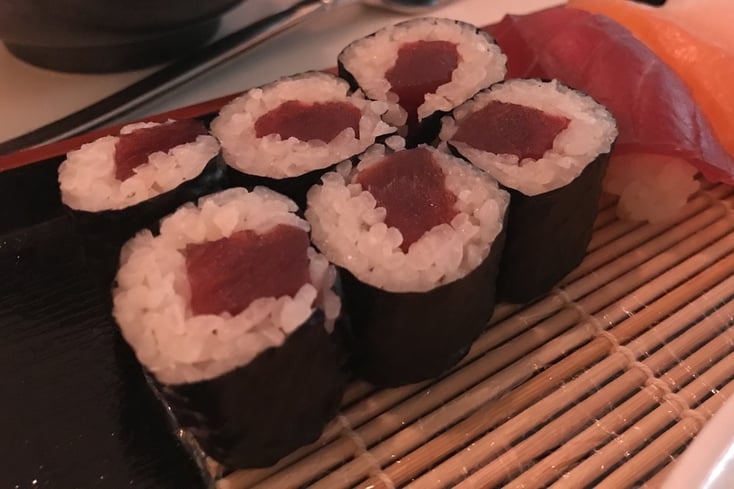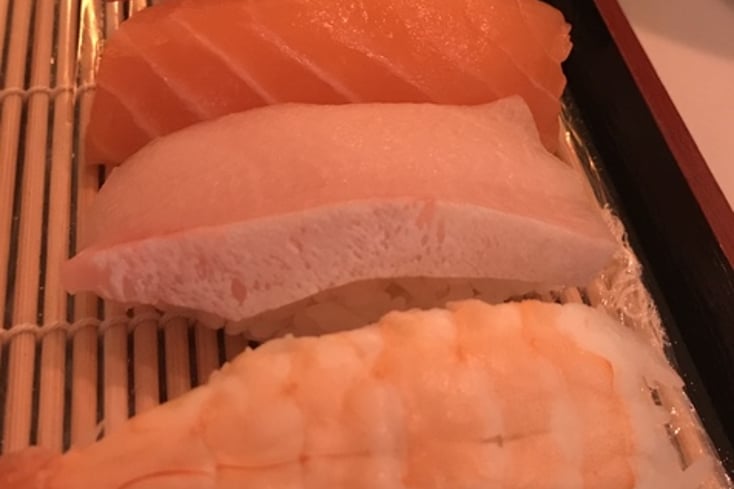Executive chef Keunsik Lee of Pod, the Pan-Asian Steven Starr restaurant located right on Penn’s campus, teaches us in his sushi class how the pros do the popular dish. He’s been working in sushi for ten years and has even worked alongside Iron Chef Masaharu Morimoto for two. This is what we learned:
The Basics
Sushi is actually defined by the combination of vinegary rice with other ingredients, while raw fish by itself is called sashimi. Ever been confused by what maki and nigiri meant on the menu at sushi restaurants? Maki is what we know as a sushi roll, while nigiri is fish over rice.
Rice
Rice is a hugely important part of sushi. There are many different kinds, but sushi rice is short-grain Asian rice, which is stickier. Chef Lee tells us that there are a variety of rice brands but a middle-range priced one will do just fine. As I mentioned before, sushi rice is mixed with vinegar and salt. Lee recommends buying pre-made packets of seasoning. Or, if you are up to mix your own, Kikkoman would be a good brand to try.
Fish
You must buy sushi-grade fish. Whole Foods, an Asian supermarket, or a fish monger are great places to start. You can also buy frozen, packaged fish that is up to standard.
Ginger and Wasabi
Now, let’s talk about the stuff on the side. We learned some interesting new facts about ginger and wasabi. For example, while today wasabi is only used for flavor, in the past it was used to sanitize the fish and control food poisoning. Additionally, the ginger that you always get on the side of your rolls is not actually meant to be eaten together with the sushi. Lee says that in Japan that’s a huge no in sushi etiquette. Ginger is actually a palate cleanser to be used between different kinds of sushi.

Maki Rolls
Ingredients
Instructions
Take a sheet of nori and place it rough side up shiny side down onto the bamboo mat. The roughness helps the rice stick better to the nori.
Keep a bowl of water on the side to wet your hands so they don’t stick to the rice. Wet your hands and take about 3/4 of a cup of sushi rice in your hand. Make sure that the rice is warm and moist. Shape the rice into a long cylindrical shape, and place it on the middle of the lefthand side of the nori.

Use your left hand to flatten down and spread the rice, while using your right hand to drag the rest of the mass over. Make sure not to smash the rice and don’t try to spread it completely.
Very gently spread the rice evenly to the edges, leaving a strip of about 3/4 of an inch at the top.
Place ingredients on top of the rice.

Slide your thumbs under the side of the bamboo mat near you and start folding the sushi over away from you. Use your remaining fingers to hold the ingredients in. Roll tightly until the tuna is fully encapsulated but there is still a strip of seaweed and rice on top. Press lightly across the mat so the roll holds its shape. Lift the edge of the mat slightly and roll it forward to complete the roll.

With a very sharp knife, cut each roll in half and then each half into three pieces. The trick is to use a quick back and forth motion and to never push down hard.

Nigiri Sushi
Ingredients
Instructions
Wet your hands with water. Take about a ping-pong-ball-sized ball of rice. Once again, make sure that it is warm and moist.

Take the rice ball between two of your fingers and hold it vertically. Use the fingers of your other hand gently shape the rice while turning it into a flat cylindrical shape. Make sure that the rice is tightly held together so that it doesn’t fall apart when you eat it later.

Put the rice cylinder in your left hand and then put a piece of your topping on top. Spin and press the sushi this time horizontally to bind everything together. Professional chefs will do this part incredibly quickly, but take as much time as you need.
Plating
The Japanese culture is all about respect, so we must respect the sushi and the consumer with the presentation. Ginger and wasabi belong on the right side of the plate. Most people are right-handed, so this placement makes for easier eating. The order you place the fish depends on the order each fish should be eaten. Starting from right to left, you want to start with white fish, then colored fish, then shellfish and toppings with strong flavors like unagi. If you eat the strongly flavored sushi first, it will be difficult to taste the subtle flavors of the others. The fish should be placed at a 45˚ angle left from 90, which also helps the consumer grasp the fish more easily.
Thoughts
We absolutely loved the sushi class at Pod and definitely learned a lot. The course also came with an appetizer and dessert in addition to the sushi that we made during class, making it a full three-course meal. While some readers may not have the opportunity to come to a sushi class at Pod in Philadelphia, with this article, sushi is definitely doable at home.









